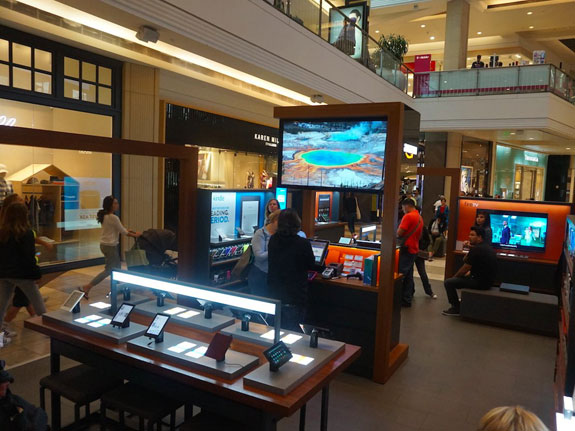Amazon is aggressively expanding its presence in the real-world retail market, with a plan to open dozens of new pop-up stores in US shopping malls over the next year, a source familiar with the matter told Business Insider.
The miniature retail storefronts are a separate effort from the physical bookstore that Amazon opened in Seattle last year and are primarily designed to showcase and sell the company’s hardware devices, particularly its Echo home speakers.
The pop-up stores, which are spearheaded by Amazon’s head of devices and services, reflect the company’s growing drive to reach consumers directly through a variety of access points including retail storefronts, home delivery, and innovative devices.
Just as Apple changed its relationship with customers through its sleek retail stores, Amazon is building out its vision for a new class retail business that weaves together a powerful assortment of online and physical components.
Pop-up stores, typically 300- to 500-square-foot locations in the middle of shopping malls, carry an assortment of Amazon hardware — including the Kindle e-readers, Fire TV, and the Echo speakers — as well as accessories. But the broader goal is to drive more traffic to Amazon’s online store, as these devices make it easier to purchase items there.
As of August, Amazon had 16 pop-up stores in the US — nearly three times as many as the six it had at the end of last year, according to the source. That number is expected to exceed 30 this year and could go up to as many as 100 by next year, as new stores are popping up almost every week in shopping malls across the country, this person said.
In fact, Amazon quietly launched a new site dedicated to its pop-up stores; it shows 21 now. The stores are spread across 12 states, including New York and Texas, with California owning the most (six).
End of the test phase

The Amazon pop-up store in San Francisco’s Westfield (Mall.Business Insider/Eugene Kim)
Amazon is hiring a number of positions for “Amazon device pop-up stores” in multiple locations that have yet to be announced, including Miami, Florida, and West Hartford, Connecticut, according to job listings.
In one of the job posts, Amazon says pop-up stores “have emerged from the test phase with a goal to expand and grow.”
Business Insider’s source said Amazon seems to be putting a lot more resources in its pop-up store expansion and that it could potentially evolve into other forms as well, such as a brick-and-mortar space similar to an Apple Store. Amazon has tested things like pop-up trucks, but those haven’t really materialized into any meaningful sales channels.
Amazon never officially announced pop-up store launches, although it did confirm the 2014 opening of its San Francisco one in the upscale Westfield Mall. And The Wall Street Journal’s Greg Bensinger discovered a smaller pop-up store in the mall a year before that.
Amazon still hasn’t closed its Westfield Mall location, despite the short-term nature of pop-up stores.
The pop-up stores come with hefty fixed costs, including leases in shopping malls and full-time employees to staff the storefronts. But they offer a new way for the company to boost its brand awareness and to drive sales, both at the stores and on its website.
Given Amazon’s obsession with data, the decision to expand the network of stores may indicate that the company has seen an uptick in online sales in the regions where it already has pop-up stores.
The pop-ups also serve a strategic purpose by providing Amazon with its own physical sales channel — something that has become especially important after big-box retailers such as Target and Walmart stopped selling Amazon devices in 2012. (Target plans to bring Amazon products back this year.)
Amazon declined to comment on its roadmap for the stores but provided this statement: “We offer pop-up kiosks so that customers can try out all our new devices and learn about our services like Prime and unique content like Amazon Originals.”
The Echo effect
One interesting part about Amazon’s pop-up stores is that they’re run by the devices team, not the retail team that opened Amazon’s bookstore last year. The initiative is led by Senior Vice President of Devices and Services Dave Limp, who oversees everything from the Kindle to the Echo.
That means the push for more pop-up stores coincides with the success of the Echo, which is widely considered to be the next big hit product for Amazon. The Echo’s success has prompted rivals such as Google and, reportedly, Apple to develop competing versions.
According to multiple sources, Amazon is increasingly putting more resources to developing the Echo and its voice technology platform, Alexa — and the pop-up stores provide an important way to raise brand awareness for both products.
Another source said Amazon played with the pop-up store concept while the Echo was being developed in 2013, as it’s a way to let people play, hands-on, with its devices, especially the unusual ones like the Echo.
“Lowering the barriers to trial and letting people feel how things actually work is a great way to start,” this person said.
It’s unclear why Amazon’s taking such a low-key approach to its pop-up store expansion. But it’s not too uncommon for Amazon to do things quietly when it’s clear that it has bigger ambitions. Amazon’s fashion team, for example, launched seven private labels over the past year — and it’s expected to overtake Macy’s as the top apparel retailer in the US by 2017.
